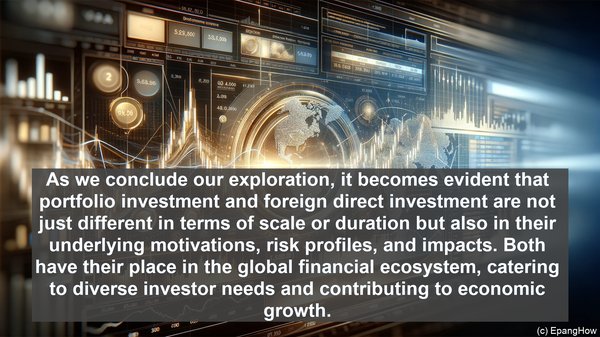Introduction: The Global Financial Landscape
Hello, and welcome to our article on the distinction between portfolio investment and foreign direct investment. In today’s interconnected world, where capital knows no boundaries, understanding these investment types is crucial. Let’s begin our exploration.

Defining Portfolio Investment
Portfolio investment refers to the purchase of financial assets, such as stocks, bonds, or mutual funds, in a foreign country. The primary objective here is to earn a return on investment, either through capital appreciation or income generation, such as dividends or interest. Unlike foreign direct investment, portfolio investment does not involve acquiring a controlling stake or actively participating in the management of the invested entity.
Foreign Direct Investment: A Deeper Engagement
In contrast to portfolio investment, foreign direct investment, often abbreviated as FDI, entails a more substantial commitment. It typically involves the establishment of a physical presence, such as a subsidiary or branch, in a foreign country. The investor, in this case, not only provides capital but also assumes a degree of control and influence over the operations and strategic decisions of the invested entity. FDI is often associated with long-term commitments and the transfer of technology, skills, and management expertise.
Motivations and Objectives
The motivations behind portfolio investment and FDI can vary significantly. Portfolio investment is often driven by the desire for diversification, seeking opportunities in different markets to spread risk. It can also be a means of capitalizing on short-term market movements or taking advantage of specific sectoral trends. On the other hand, FDI is frequently guided by strategic considerations, such as accessing new markets, securing resources, or establishing a global production base. FDI is often seen as a long-term commitment, with the investor aiming for sustainable growth and market presence.
Risk and Return Profiles
Portfolio investment and FDI also differ in terms of risk and return profiles. While both involve some level of risk, portfolio investment is generally considered more volatile. Fluctuations in stock prices, interest rates, or currency values can significantly impact the value of the investment. However, portfolio investment also offers the potential for higher returns, especially in cases where the investor has a keen understanding of market dynamics. FDI, on the other hand, is often associated with more stable, albeit moderate, returns. The investor’s control and influence over the invested entity can help mitigate certain risks, but the long-term nature of FDI means that returns may take time to materialize.
Implications for Host Countries
Both portfolio investment and FDI can have significant implications for the host country’s economy. Portfolio investment, with its potential for rapid inflows and outflows, can contribute to market volatility. Sudden withdrawals by portfolio investors, often referred to as ‘hot money,’ can destabilize currencies and financial markets. FDI, on the other hand, is often seen as a more stable source of capital. It can create employment opportunities, transfer technology and skills, and contribute to overall economic development. However, there can also be concerns about the outflow of profits and the potential for the investor to have undue influence over the host country’s economic policies.

